Overview/Background of Event
With all this happening, the Championships attracts in excess of over 1,700 exhibitors and up to 297,000 visitors.
NPA History 1931-2023
FORMATION & ORIGINS OF THE NATIONAL PLOUGHING ASSOCIATION
1931 – 2023
We can only guess at the number of centuries during which local ploughing competitions have been taking place, but records tell us of a match in Camolin Park, Wexford on 20th October, 1816.
On that occasion, a special prize of £5 was put up for the carpenter or ploughmaker who produced the best and cheapest plough made by himself and who contracted to supply the public with similar ploughs at the same price.
Between 1816 and 1930, ploughing competitions thrived between neighbouring parishes, the competition was good and people were enthusiastic but there was no goal to strive for.In 1931 the Republic of Ireland had suffered the impact of the War of Independence and the dreadful wounds of its own Civil War still festered. It was passing through a bruising economic depression, but the Irish way of life went on much as usual. What better antidote to widespread national anxiety than vigorous debate about the comparative skills of the men who tilled the land?
Minister for Agriculture, Paddy Hogan, had pinpointed the challenge of the day with the clarion cry “one more sow, one more cow, and one more acre under the plough”. His challenge seemed to have been ignored. The wheat acreage for 1930 had declined to one of the lowest points at just over 20,000 statute acres, since records were kept.
Two men who lived very close to the hard core of Irish politics, the late J.J. Bergin, from Athy, a progressive farmer and Civil Engineer, and farmer Denis Allen of Gorey, sought the relief of just such a safety valve. They debated which county had the best ploughmen, Kildare or Wexford. Interest was generated at once. Local ploughing matches and challenges were common and had probably existed in one form or another since the first horse, plough, or race in Ireland but the idea of an Inter County Ploughing Contest had never arisen.
The debate resulted in the inevitable challenge. The pick of the ploughmen in Kildare would meet the pick of the ploughmen in Wexford in a field combat. The competition would take place at a time when it was widely believed that the plough was Ireland’s only redemption. The excitement of the prospect made the two men contact tillage farmers in other counties, and on the 16th February, 1931 nine counties met in competition on the “plains of Kildare”, Coursetown, Athy – the same venue of the 2011 National Ploughing Championships.
And so it was, the National Ploughing Association was born. The cost of running this first event was £9.3.5. The competing counties formed a committee, drawing up rules and conditions with the main objective “to bring the message of good ploughing to all parts of the country and to provide farmers with a pleasant, friendly and appropriate place to meet and do business.”
It may interest you to know that Wexford won that first challenge, but if Denis Allen triumphed over his old friend it did not last long, for it was lost in the size of the enterprise they immediately put in train. With J.J. Bergin now firmly at the helm, the two men were set on an irreversible course forward.
The competing counties formed a committee. Rules covering standards and regulations at parish, county and national level were agreed. The NPA was the first in the world to organise ploughing matches on a national level.
THE DEVELOPMENT OF PLOUGHING
After the first Championships, there was much debate about the type of ploughing which should be deemed standard or best. Finally, a so called “National Style” was adopted. This, when properly done gives a well skimmed sod, turned well over, with a round back, giving a firm bed and suitable for modern tillage implements. Only 3 poles were allowed at the making of the middle and the time limit for ploughing a rood (plot) was five hours.
The second championships held in Gorey Co Wexford on 19th February 1932 were a resounding success and attracted an attendance of 3,000 and was printed in the daily papers.
Throughout the years, the NPA had witnessed at first-hand, extraordinary change in farming and all its technology. In the earliest days of NPA, Ireland’s total exports, largely the products of our farms, were worth £35.5 million. They were to slump to £17.5 in 1934 as the Great Depression advanced. That was hardly the time for progress in farm mechanisation, but it was nonetheless the time of change from the traditional horse to the emergent tractor. Ford were predominant as the market leader of the day. A decade later came Ferguson.
The National Ploughing event provides a major marketplace for all inputs of farming and is favoured by many manufacturers because it offers scope to show products in a natural setting and even under working conditions on the demonstration plots. At a national level the annual Championships constitute very big business as keen competition among the nation’s top ploughmen.
Within a few years of its foundation it had become one of the major national annual events in Ireland attracting publicity, manufacturers, traders, and senior politicians notably Eamonn De Valera, which created another dimension of glamour for the rapidly growing largest field event in the world. The crowds followed and grew as ideas and progress cross-pollinated. The championships attracted the best minds, the best men and the most industrious progressives within farming Ireland right from the very beginning. Ballads were composed about the ploughmen and the contests and were sung throughout the land.
During World War Two the NP Championships continued in Ireland without break throughout the war years. There were adjustments to meet the difficulties. For example, between 1939 and 1946 the senior ploughing championships were held at one venue and the junior championships at another.
Club and County Ploughing Associations started to spring up around the country and as interest increased, more competitions were introduced to meet the various levels of competitors. Increasing numbers of people were getting involved in the association through ploughing, judging, stewarding and co-ordinating the event. All of which was and still is voluntary. The National Ploughing had grown rapidly in the space of one year, two ballads were composed about the ploughing and the contests and were sung or recited with cheers and gusto throughout the land. One was written about one of the great personalities of the Championships who won the National Title in 1932 and was a champion ploughman for over two decades Michael Redmond, The Ballagh, Oulart, Co. Wexford.
1933 – 15TH FEBRUARY – CLONDALKIN, CO. DUBLIN
The internationally renowned Royal Dublin Society (RDS) having celebrated 200 years of service to Irish Agriculture in 1931 elected to bestow the RDS Silver Medal on the Individual Winner of the Championships each year and a solid silver Perpetual Cup to be awarded each year for the best turned out pair of Irish Draught horses in the National Competition – this prize is still presented today.
In order to spread interest in good ploughing and urge people to take part the Department of Agriculture, in 1933 permitted the county committees of agriculture to make a grant of money to Ploughing Committees who entered teams.
1934 – 13TH FEBRUARY – ATHENRY, CO. GALWAY
In the four years since the inception of the National Ploughing Association, the number of counties competing had increased from 9 to 17. The ringing of a hand bell about 10 o’clock will indicate that the draws are about to take place. Competitors or their managers should proceed at once to the place indicated as late comers will get the first undrawn plots and horses.
1935 – 13TH FEBRUARY – MALLOW CO. CORK
1936 – TULLAMORE, CO. OFFALY
1937 – 9TH FEBRUARY – GREYSTONES, CO. WICKLOW
In this year it was decided to grade counties into Junior and Senior. The Ploughing was becoming a social event also with a dance and supper on the eve of the match and a dinner dance on the night of the match. This year a pipe band started and finished the contest.
1938 – 10TH FEBRUARY – OAK PARK, CARLOW
Carlow Vocational Education Committee organized a horse shoeing competition and there was a sheaf throwing competition – this was a tremendous attraction and received great local media coverage.
1939 – 8TH FEBRUARY – KILLARNEY, CO. KERRY
Accommodated cost between 4 pounds and 6 shillings and 9 pounds. Special coats were worn by Team Managers for identification. World War 2 erupted in September of that year but despite this the National Ploughing Championships continued without a break throughout the war years but the competitions were divided between two venues.
1940 1ST FEBRUARY, KILKENNY – SENIOR CLASS
24TH JANUARY, THURLES, CO. TIPPERARY – JUNIOR
THE SIGNS OF COMMERCIAL POTENTIAL
The commercial potential of the Championships was evident as early as 1932 with the National Media reporting the make of the winning plough mostly Pierce and Star and the competing manufactures were quick to seize the opportunity. The name of the winning competitor would also be printed. J.J. Bergin put his entire talent, drive and enthusiasm into the NPA, and within a few years it had become one of the major national annual events in Ireland, attracting publicity, manufacturers, traders and inevitably the senior politicians. Eamon de Valera, President of the Executive Council of the Irish Free State was pictured at the match in 1938 with the caption “Man of the People”. In 1939 twenty four companies exhibited at the Match in Killarney.
1942 – 12TH FEBRUARY – CLOGHRAN, CO. DUBLIN
The first tractor ploughing class was introduced – this was a massive breakthrough but it would take some time before the farmers of Ireland would put their horses to pasture and use a tractor in their place.
1946:
Another development had taken place which elevated the Championships to the level of a state occasion with President Sean T. O’Kelly becoming a regular visitor, thus lending to the event enormous atmosphere and glamour.
THE EVOLUTION OF MECHANISATION
In the late forties and early fifties mechanisation ended an era of horse traction and as a last nostalgic gestures to the horse in award form came in 1951. The Irish ropes presented a pair of Irish made reins to each competitor and team manager.
The signs of change were long in evidence with a tractor appearance and demonstration in 1932. The NPA introduced the tractor competitions for the first post war championships in 1946 and was sponsored with a magnificent trophy for the supreme champion was Vigzol Lubricants. By the end of the fifties the noise of motor on plots demonstration and competition arena could be heard for miles. In the early years the competitions were predominately Horse Ploughing as farm mechanisation was in its infancy.
World War erupted in 1937 but despite all the turmoil all over the World the National Championships were held, but the world crisis put a slow down on the progress of mechanisation.At the event in Ballinasloe in 1944 as many as 90 pairs of horses were borrowed in the area for the Championships.
In the early post war years interest in machinery was regenerating and the NPA introduced the tractor competition which was confined to makers, importers or distributors in 1946. Using what was known as the ‘Iron Horse, B.M.B., 2 Wheel Tractor, Trusty or Auto-Cult ranging from 3 ½ hp to 6 hp. The first National Senior Tractor Championship emerged in 1949.
The late 40’s and 50’s saw a huge transformation which would be marked in history, as this point forward saw the demise of the horse and the growth of horse power.The ploughing was an ideal venue to show and demonstrate new inventions and in 1948 the Rotary Hoe, Clifford Rotary Cultivator, Howard Rotavator, Disc Plough, the one-way plough and the gang disc harrow were additions to the exhibition.
In the same year the Macra na Feirme Perpetual Cup for the best work done by a member of Macra was introduced. It’s an interesting fact that both Henry Ford and Harry Ferguson were recognisably of Irish stock and Cyrus Hall McCormick, the man whose invention of the reaper was the seed of International Harvester, was Irish too.
1949 – Drogheda
New Inventions – A prize of a Silver Medal for exclusive design for new inventions.
Anna May McHugh joins the NPA
Having started working with J.J. Bergin in 1951, Anna May McHugh was made Secretary of the NPA in 1955 and in March 1958 J.J. Bergin, founder of the NPA died leaving a legacy for many generations to come.
1952 Establishment of the WPO
J.J. Bergin was a man with tremendous foresight, and in 1952 he ensured that the Republic of Ireland would be part of the inception of the World Ploughing Organisation. He attended the first meetings and for his contribution was appointed as Vice President. The first World Contest was hosted by Canada in 1953, and the second here in Kerry in 1954. Killarney, Ireland was the first European venue and 10 countries competed. The Cairn of Peace was originally introduced at the first world ploughing championships in 1952. The theme then “Let Peace Cultivate the Land”. The Cairn incorporates stones from each participating country. Each country send a piece of stone inscribed in their native language for inclusion in the Cairn. It represents the ethos of peace between all nations for the duration of the sporting competition.
1954 – KILLARNEY
In this event 25 competitors out of 44 lost their furrow mark for exceeding the time limit. The 12 best competitors were selected to plough in a Test Match to select two to represent Ireland in the World Ploughing Contest to be held in Killarney in October 1954. The Test Match was held on 27th February, 1954 and the winners were William Murphy, Dublin and Ronald Sheane, Wicklow. Ronald Sheane from Togher, Kilbride, Co Wicklow was selected on merit to represent Ireland at the Worlds Ploughing Championships at Killarney in October 1954.
The National Championships was very much a men only affair. JJ Bergin proposed a “Farmerette” class for girls, single, married or widowed without reference to age, the winner to be known as the “Queen of the Plough”. Women now compete in the ploughing matches. Competing in 1954 were: Miss Louth, Annette Blair, Jean Emily Burns, Mary McGrath, Cecila Dunne, Miss B Lawless and Eliz Mac Elligotte.
NPA BECOMES A LIMITED COMPANY
By 1955 the National Ploughing Championships became a 2 day event, sparked by the increasing number of competitions and the growing exhibition was gaining broader recognition every year. The Association also became a limited liability company in this year incorporated on 2nd March 1956. The number of directors is limited to forty. Liability is limited by guarantee there are no share. Period of office is for one year. The cost of running the National Event in 1955 was two thousand three hundred and twenty seven pounds, 10 shillings and 7 pence. That year the Queen of the Plough was presented with a Silver Crown of celtic design purchased in “Weirs” of Grafton Street, it was valued at £200.
1956
A new marriage incentive was introduced. The “Queen of the Plough” would be given the sum of £100 if unmarried and not over 25 years of age on her wedding morning. Bergin’s scheme was a resounding success.
Quote from newspaper “thousands of ploughing enthusiasts from all of the country flocked to Nenagh, Co. Tipperary, last week for the National Ploughing Championships.”
THE END OF AN ERA
In early 1958 it was clear that JJ Bergin’s health was failing, his health for the previous year had not allowed him to take his usual part in ploughing affairs. His condition gradually failed and he died on 13th March, 1958 in Maybrook, Athy, Co Kildare at the age of 77. He was a farmer, a civil engineer, an avid sportsman, an inventor, an editor and on occasion a member of numerous associations including amateur dramatics and Muintir na Tire. After the death of JJ Bergin, the NPA appointed the All Ireland medal winning hurling star Sean O’Farrell as Managing Director a position he held until his death in 1972.
1959 – 28TH AND 29TH JANUARY – BURNCHURCH, KILKENNY.
A national bread baking competition was introduced by NPA in co-operation with ESB and the first National Winner was Mary Turner, Main Street, Carrick-on-Shannon, Co. Leitrim.
A WORLD PLOUGHING CHAMPION IN 1964
By the year 1964 the NPA were sending 2 competitors to the World Ploughing and this was to be the year that the Republic of Ireland won our first World Title. The late Charlie Keegan, from Wicklow was the competitor and his was a huge achievement at International Level, proving to budding competitors that we had the standard and the potential to compete with the best in the World. On arrival home from the World Contest in Vienna, Charlie was brought home to Wicklow on an open top bus to meet bonfires along the roadside to greet the World Champion. His fellow Irish Competitor was Andrew Cullen, Wexford.
At the National Championships this year a new class was introduced for boys Under-28 and over 21 on the 1st of January of the competition year.
1965 – ENNISKERRY, CO. WICKLOW
National Ploughing had to be cancelled for one week due to snow. In this year Esso came on board as NPA sponsors and introduced the Esso Supreme Trophy which is still presented to the Senior Conventional Champion annually.
1966 – ROSEGARLAND, WELLINGTONBRIDGE CO. WEXFORD
A new competition was introduced to cater for students from the Agricultural Colleges. The competition was an instant success and was sponsored by Henry Ford & Son, Cork.
1969 – ROCKWELL COLLEGE, TIPPERARY
So that the ladies would become more interested in the National Championships the ICA were invited to give demonstrations in cookery, crafts. This also combined an appearance from Country Markets as the ploughing was a venue to sell produce.
1971 – Finglas, Co. Dublin
The National Championships was very poorly attended – Dublin Traffic had obviously frightened country folk and it was considered a financial loss for the association.
1972 – Rockwell College, Co. Tipperary
Just weeks before the National Championships on 25th/26th October Sean O’Farrell, Managing Director of the National Ploughing Association died.
1973
Anna May McHugh took over and was appointed Managing Director in May of 1973, she also retained her position as Secretary of the NPA.
STEADY PROGRESSION OF THE NPA
By the early seventies the machinery exhibition had grown beyond all expectations and demonstrations proved to be of great interest to spectators. The 1973 World Contest was a 4 day event with an attendance of over 100,000 people, 25 countries took part and the event was a huge success.
1974 – WATERGRASSHILL, CO. CORK
At this point the numbers attending the ploughing were so great that bars and food tents had to be erected to cater for the visitors. Sheep Dog Trials were also introduced to the Ploughing.
1975 – BENNETTSBRIDGE, KILKENNY
Number of exhibitors was 100, number of counties competing 21 and number of demonstrators 18. Interest was increasing in the side shows at the Ploughing which included Threshing, Vintage Displays, Sheaf Tossing and Bale Collecting.
Quote from journalist Nick Furlong: “I learn that one further amazing statistic was chalked up, but I have no confirmation. I was informed by a colleague from the Cork Examiner that there were up to forty more trade stands at the championships site in Wells than there was at the World Ploughing Championships in Rosegarland two years ago. The mind boggles at the accomplishment and the potential”.
1978 – KNOCHTOPHER, CO. KILKENNY
President Paddy and Mrs. Hillery were guests at the Ploughing and there were band recitals during the event.
1981
On the occasion of the NPA Golden Jubilee, the NPA hosted the World Ploughing Contest for the 3rd time. In addition to ploughing, the programme included vintage, bread making, tug-o-war, farm inventions.
CHALLENGING TIMES IN THE 80’S
Until the 80’s, the Ploughing was primarily a place for farmers and exhibitors. But things started to change and more women and farm families started attending the event. While keeping the focus of the event primarily agricultural, the event was in obvious need of some diversity.
At this stage the ICA and Country Markets started giving cookery and craft demonstrations. The ESB introduced the National Brown Bread Baking Competition, Teagasc and the National Dairy Council also introduced an interesting programme to their exhibition. NPA started using Trakway for internal site roadways from the early 80’s.
- Fashion Show in 1981
- Livestock Section in 1987
- Nissan Classic 1989
- Introduction of Shopping & Business Arcades 1985
- Kverneland World Class Challenge
Attendance figures grew very steadily throughout the seventies and eighties to the extent that in 1988, the event was extended to 3 days in order to ease some of the traffic congestion.
1986 – WOODSGIFT, CO. KILKENNY
Sprinklers has to be brought in to keep the dust down.
1987 – CHARLEVILLE ESTATE, TULLAMORE
A second shopping arcade had to be erected due to demand for indoor space. Tullamore Tribune 10-10-87 quote: “Tullamore this week has become the throbbing heart of Agricultural Ireland.”
1988 – OAK PARK, CARLOW
The Ploughing becomes a 3 day event. The NPA introduced a special competition to challenge world class ploughman to use a standard match plough new from the factory without adding any of their own attachments to the plough. The class was called the “Kverneland World Challenge” and became a class that attracted huge interest over a decade. This year the Intermediate Tractor Ploughing Class was introduced.
ANOTHER WORLD CHAMPION FOR IRELAND
It was a full 30 years on since Charlie Keegan won the World Contest in 1964, Wexford man Martin Kehoe brought the title back to Ireland after winning the World Contest in New Zealand. Martin joins the realms of the greatest ploughmen in the world having won the contest 3 times. Fellow Irish Competitor John Tracey from Carlow is the only man to have been runner-up in the World Contest on 7 occasions.
REVERSIBLE PLOUGHING IS INTRODUCED
Until 1995 the World Ploughing Contest was for Conventional Ploughs only with regulations then changing to introduce the reversible plough and now every country are obliged to enter at least one Reversible Plough Competitor in the World Contest – another sign of the times. The National Ploughing Association introduced the first Reversible Ploughing Class in 1992. The Under-28 Reversible Class started in 1998 and in 2011 the NPA introduced the Intermediate Reversible Class.
1996
The NPA hosted the World Contest yet again over 4 days, the number of participating countries on this occasion was 28.
COMPETITION PLOUGHING AS STRONG TODAY AS EVER
In 1931 – 9 counties took part in the National Ploughing Championships in Athy, in 2011 – twenty six counties competed plus visiting competitors from Northern Ireland and abroad. In 1994 over 270 competitors took part in the National Finals, which grew to over 320 competitors in Athy in 2011. In 2011 the NPA introduced a new ploughing class “The Intermediate Reversible”, revived the Macra Ploughing Class and passed a motion to permit each country to send a third competitor to the National Finals in the Conventional Senior/Intermediate or Junior Grade. All very positive signs of a very healthy interest in the sport of ploughing.
TRADE EXHIBITION PEAKS
By the mid 90’s the Trade Exhibition was absolutely thriving, obviously the economic environment played a key role as well as the advent of higher technology. Machinery on an annual basis, new products, new ranges and the many agri-services now operative in the agricultural sector. The amount of trakway that NPA had laid meant that the infrastructure of the Event became much more professional and secure.
Potential exhibitors from outside the agricultural sector saw the Ploughing as a great opportunity to sell products, meet potential customers and increase brand awareness and so the “Tented Village” era developed very significantly at the Ploughing throughout the 90’s and early 21st century. In 2011 the NPA had 14 Arcades facilitating 240 exhibitors.
Numbers of exhibitors grew steadily throughout the mid – late 90’s and specialist categories started to emerge in early part of the new century. These included Forestry Village, Motor Show and more recently the Renewable Energy Division. Government Departments became regular exhibitors at the Ploughing as well as many state and semi stage agencies and National Associations and Organisations. More recently the Tourism Industry have started to participate in a big way in the ploughing, Enterprise Ireland bring delegations from a number of countries to review the event and exhibitors are travelling from as far as Belgium, Netherlands, Germany, Poland and the USA.
THE CYCLE OF PLOUGHING SINCE 1931
At this year’s National Match in Ratheniska you will see:
- Loy Digging – an ancient art of turning the soil to prepare the ground for a crop that precedes ploughing.
- Horse Ploughing – which was the main method of ploughing in 1931.
- Vintage Tractor Ploughing – with what was the modern machine in the late 40’s
- Conventional Ploughing – 2 or 3 furrow ploughs and using mostly 2 wheel drive tractors.
- Reversible Ploughing – using 4 wheel drive, high horse power and highly automated tractors.
Conventional ploughs are already fast becoming a vintage method of cultivating the land – with highly technically 7/8 furrow Reversible ploughs now in situ. The theory exists that the value of the plough is fast diminishing to be preceded by more modern cultivation equipment – however experts in the field still claim that good ploughing prepares the most conducive seed bed.
THE NPA TODAY
Now in its 92nd year:
- Event costs in excess of €6 million to run.
- Ploughing Associations in every county in the country.
- The biggest National Ploughing Championships in the World.
- Over 320 competitors in the National Finals.
- 19 All-Ireland Ploughing Title Classes.
- Ireland’s primary Agricultural Exhibition.
- One of the largest Agricultural Events in Europe.
- Many international visitors, exhibitors and delegations from right around Europe and as far afield as New Zealand.
- An average of 300,000 visitors.
- Up to 1,700 Trade Stands
- Billions of pounds worth of the most modern agri-equipment in the World on exhibition at the Championships.
- Still a voluntary association depending on voluntary efforts of our members from all around the country.
- 92 years this year
Today the evolution of the Association means that the NPA work with many groups and organisations in the planning of the event. These include:
- County Councils
- Gardai
- Fire Services
- HSE
- Health & Safety Authority
- Media
- Land Owners
- Residents
- Rural Organisations/Clubs
- Organising Committee
- Order of Malta
- Plumbers
- Electricians
- Fencing Contractors
- Security
- Event Controllers
- Ticketing Solutions
The National Ploughing is an empire which has played a significant role in promoting and highlighting the plight of Irish Agriculture since 1931.
But in that time an amazing amount of development, mechanisation, technology has changed the face of our society. The Mission Statement for the Association in 1931 was:
“To bring the message of good ploughing to all parts of the country and to provide a pleasant and friendly place to meet and do business”.
Did the association live up to this Mission Statement – there is no doubt but that it has tenfold.
With thanks to Larry Sheedy for contributions to the History of the NPA Also the late Michael Dillon, Nicholas Furlong, Michael Connolly.
This article is composed from various news clippings and documentations of the NPA down through the years. The NPA are not accountable for any inaccuracies herewith.
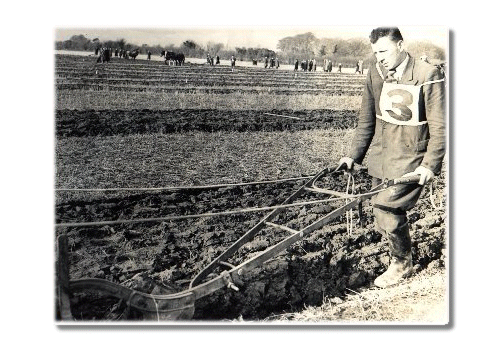
The First National Ploughing Contest was held in Mr. W.K. Hosie’s field, Coursetown, Athy.
A Perpetual Challenge Cup was donated by the Estate Management and Supply Assoc. Ltd., Kildare,
“..to be competed for anually in a contest for the Senior Individual Ploughing Champion of Ireland.”
A team trophy was also presented for the contest, the “David Frame Cup”.
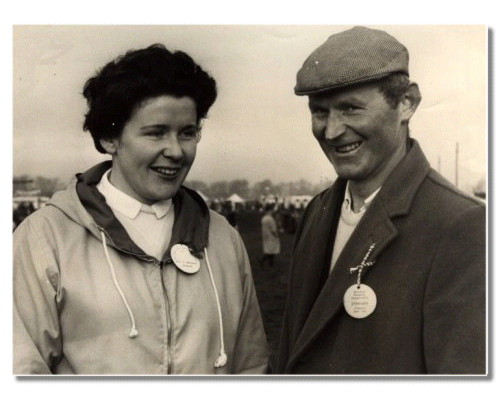
Anna May McHugh, secretary of the N.P.A., enjoying the company of Murty McGrath
at the 1957 Ploughing at Boyle.
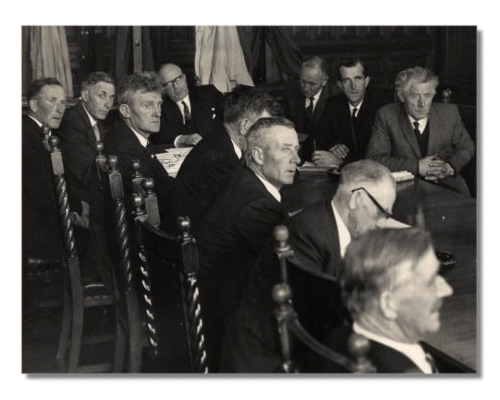
A look behind the scenes reveals how the important decisions are made at a general meeting of the National Ploughing Council.
Pictured at this meeting are clockwise;
M. Connolly; H. McDonald; G. Baker; B. O’Connor; M. Hanlon; J. Savage; J. Lennon
D. O’Connor; A. McMahon; D. Connolly; & J. Mullins.
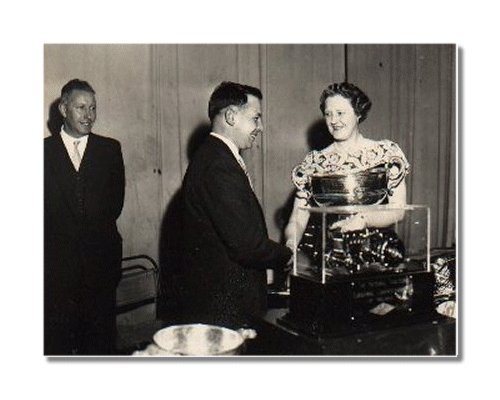
Pictured receiving The Golden Grain Perpetual Cup from Beatrice Grovenor at the
1954 World Ploughing Championships at Killarney is Mel Holohan.
Onlooking is Gerry Moyles, CAO.
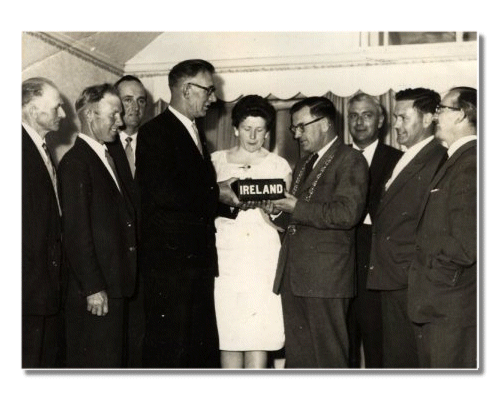
Ireland’s contribution to Rome’s Cairn of Peace in 1960 was a distinctive block of Kilkenny marble.
Photographed here before departure are left to right:
J. Savage; A. Cullen; M. Muldowney; S. O’Farrell; A. M. McHugh; JH. O’ Donovan, ESSO; & Count I. O’Kelly
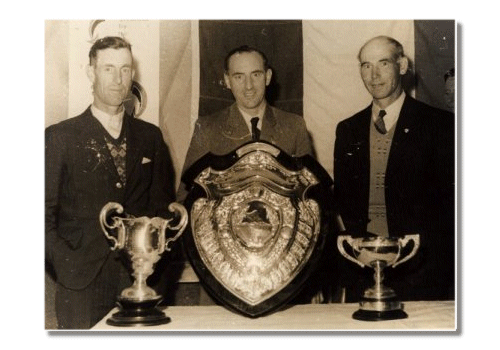
Thomas McDonald on the left, who had a distinguished career in competitive ploughing is photographed here
after the presentation of the Minister for Agriculture Shield which he won at Kilkenny in 1959.
Included are Thomas Murray, CAO, and Joseph Byrne who also represented Carlow in that event.
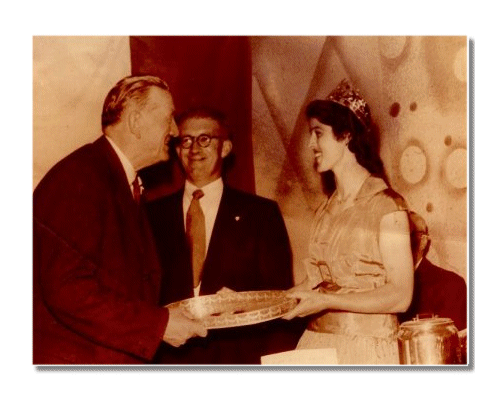
Paddy Smith, Minister for Agriculture, makes a presentation to the 1959 Queen of the Plough, Muriel Sutton.
In the centre of the picture is Paul Dunican, who was a trustee of the N.P.A. at the time.
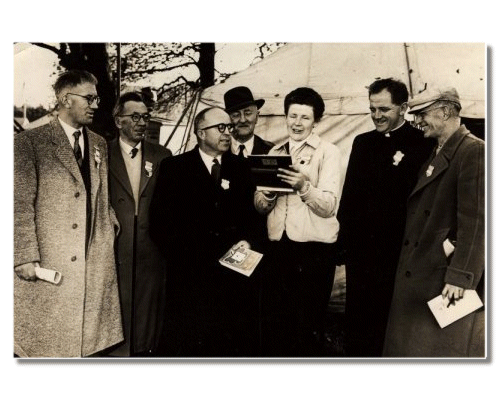
Oak Park 1959. Left to right:
Paul Dunican; John Crowley: MT Connolly; J.J. Ruane; Anna May McHugh; Fr. Seán O”Leary P.P.; & J.J. Murphy.
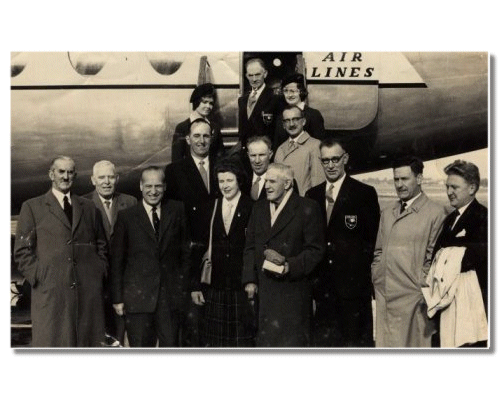
Boarding for the World Championships in Rome in 1960 are:
Front Row: DC Hearne, Michael O’Connor, Percy Lyons, Anna May McHugh, Tom Sutton, Sean O’Farrell, John O’Donovan.
Second Row: Michael Muldowney, Andy Cullen, Count Ian O’Kelly.
